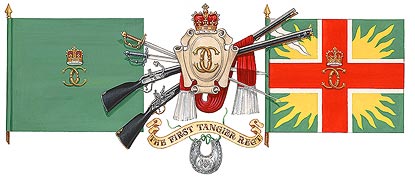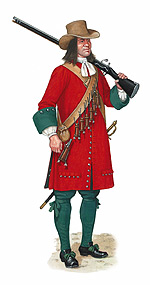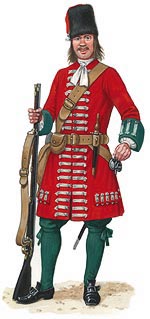The Raising Of The Regiment And Tangier
1661-1684

 |
| A musketeer with matchlock and bandolier of cartridges" |
On 14th October 1661, The Tangier Regiment, later to be known as the 2nd Regiment of Foot and the Queen’s Royal Regiment, was first paraded on Putney Heath under the command of the Earl of Peterborough. The Regiment was raised to garrison the port of Tangier in North Africa, which King Charles II had acquired as part of the dowry, when he married Catherine of Braganza, the Infanta of Portugal.
This was in the early days of the Regular Army, as ex Royalist and Cromwellian troops were forged into a new force. The new Regiment, which arrived in Tangier in 1662 was joined by parliamentarian companies from the garrison of Dunkirk and two units from the Royalist Force, which had been serving in Flanders; they officially took over Tangier from a small naval garrison. The Portuguese inhabitants were not happy with these arrangements and left on the British ships, leaving a civilian population made up of only wives and families of the military.
Tangier was considered a valuable acquisition, as it commanded the entrance to the Mediterranean and was ideal as a trading centre, however, there had been years of previous conflict with the Moors. In addition, Tangier needed a mole to protect its harbour from the Atlantic weather and the building of this lasted the next twenty-two years of English occupation.
 |
| A Grenadier c1678. |
War broke out with the Moors in 1663 and after some heavy casualties a truce ensued. However war began again, when the new Governor, The Earl of Teviot, a soldier of fortune who had served with the French Army until 1660, took command. He began extending the fortifications, which resulted in fierce fighting, but during a sally in May 1664, he was killed and by that stage of the occupation, half the garrison had died. Lord Bellasye, the new Governor concluded a peace and returned to England leaving Colonel Norwood in command. Unfortunately, Norwood died in 1668, followed by his successor, the Earl of Middleton, in 1675; the new Governor was then the Earl of Inchiquin.
In 1680, the pressure from the Moors increased, as the Emperor of Morocco joined forces with the Chief of Fez in order to pursue a bloody war against all Christians in North Africa. Reinforcements were needed at the Garrison, which was raised to 3000 in number. Colonel Fairborne briefly took command, before his death, and in April 1682 Colonel Pierce Kirke was appointed Colonel and Governor.
Tangier was evacuated in 1684, as the cost of maintaining the Garrison had become too high. A fleet was sent to demolish the mole and the fortress and the Regiment left in April after twenty-two years gallant service. The battle honour of TANGIER 1662-1680 was awarded to the Regiment in 1909 and is the oldest in the British Army; the only other regiment to hold this distinction for the full garrison period is the Household Cavalry Regiment. It is still proudly emblazoned on the Colours of the Princess of Wales’s Royal Regiment, the modern successor of the Tangier Regiment.

